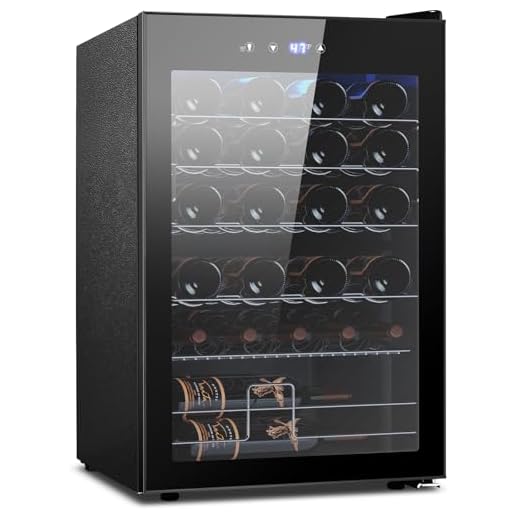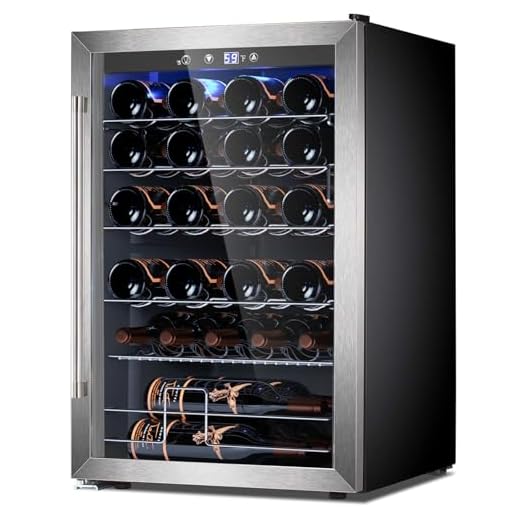



Storing these beverages at a temperature between 55°F and 65°F is optimal. This range allows the complexities of flavor to fully develop while maintaining a balanced profile. If the ambient temperature exceeds 70°F, consider a chilling option to preserve quality.
Before serving, a brief stay in a cooler can enhance the tasting experience. A temperature drop of about 10°F can make a noticeable difference, especially on warmer days. It’s worth experimenting with slightly cooler temperatures to find the ideal balance for your palate.
When it comes to storage, a stable environment is crucial. Avoid places with fluctuating temperatures, such as kitchens or areas near windows. A dedicated wine cooler is an excellent investment for enthusiasts who wish to maintain the integrity of their collection.
Ultimately, understanding the proper handling of these beverages can elevate your enjoyment. Experiment with different temperatures and find what works best for your preferences, as the right approach can truly enhance your tasting experience.
Do Red Wines Require Refrigeration?
It’s not necessary to chill full-bodied varieties, but a slight drop in temperature can enhance their flavor profile. Aim for serving them between 60°F to 65°F (15°C to 18°C) for optimal enjoyment.
For those with a preference for a lighter style, consider cooling them slightly before consumption. A temperature around 55°F (13°C) can bring out the nuances of fruity notes.
Storing these beverages at room temperature is generally acceptable, but avoid exposure to heat sources and direct sunlight. Ideal conditions include a consistent environment, away from extreme fluctuations, ideally around 55°F to 65°F (13°C to 18°C).
When it comes to serving, if a bottle has been opened and not consumed entirely, recork it and place it in a cool spot. If you plan to save it for more than a day, consider placing it in the refrigerator to preserve its integrity.
Here’s a quick reference table for optimal serving and storage temperatures:
| Type | Serving Temperature (°F) | Storage Temperature (°F) |
|---|---|---|
| Full-bodied | 60-65 | 55-65 |
| Lighter styles | 55 | 55-65 |
In summary, while not mandatory, slight cooling can enhance certain characteristics, and proper storage ensures longevity and taste preservation.
Understanding the Ideal Serving Temperature for Red Wines
The optimal temperature for serving these beverages typically ranges from 55°F to 65°F (13°C to 18°C). This allows the complex flavors and aromas to be expressed fully. For lighter varieties, aim for the lower end of this spectrum, while fuller-bodied options benefit from being served slightly warmer.
To achieve the desired temperature, consider the environment. If the room is warm, chilling the bottle for about 15-30 minutes in an ice bath can be effective. Conversely, if the environment is cool, simply letting the bottle sit at room temperature for a short duration may suffice.
Temperature can significantly influence perception; serving at too high a temperature can accentuate alcohol, leading to a less enjoyable experience. On the other hand, serving too cold can mute the flavors, masking the wine’s true character. Always aim for balance to enhance the tasting experience.
Keep in mind that various factors, such as the wine’s age and composition, can affect the ideal temperature. Younger bottles with robust tannins may thrive at a slightly warmer temperature, while older selections, which are generally more delicate, benefit from being served closer to the cooler end of the scale.
Ultimately, personal preference plays a key role. Experiment with different temperatures to find what resonates with your palate. Understanding how temperature impacts the tasting profile can elevate your enjoyment and appreciation of these exquisite beverages.
How to Properly Store Opened Wine
After uncorking a bottle, it’s crucial to minimize exposure to oxygen. Always reseal the bottle with its original cork or a wine stopper to limit oxidation. It’s advisable to keep the bottle upright, as this reduces the wine’s contact with the cork, preventing it from drying out and allowing air to seep in.
Maintain a consistent temperature, ideally between 55°F and 65°F (13°C to 18°C). If you’re unable to store it in a wine cellar, a cool, dark place in your home can work. Avoid areas with temperature fluctuations, such as near heat sources or in direct sunlight.
Short-Term Storage Tips
For short-term storage, consume the bottle within three to five days. Keep it in a cool, dark cupboard or a dedicated wine fridge if available. If you have a partial bottle left, consider using a vacuum pump to remove excess air before sealing it again.
Long-Term Considerations
If you anticipate keeping the opened bottle for more than a week, consider transferring the remaining liquid into a smaller container to minimize air exposure. Ensure the container is clean and has a secure lid. This practice can extend the wine’s life significantly and help preserve its flavors.
Impact of Temperature on Wine Flavor Profile
The ideal temperature for serving is critical for the expression of flavors in a glass. Generally, a range of 60°F to 65°F (15°C to 18°C) allows for optimal flavor release. At this temperature, the bouquet is more pronounced, and the complexity of aromas can be fully appreciated. Serving at lower temperatures can mute the nuances, while higher temperatures may amplify alcohol, overshadowing other components.
When the temperature drops below the recommended range, fruit flavors become subdued, leading to a less enjoyable experience. Conversely, serving too warm can result in an overwhelming sensation of heat, detracting from the overall balance. It’s essential to experiment and find the sweet spot for different varietals, as each may have its preferences.
For those looking to maintain the integrity of an opened bottle, consistent temperature control is vital. Fluctuating conditions can lead to oxidation, altering the intended flavor profile. Using a wine cooler or thermoelectric unit can help achieve and maintain the right environment.
In addition to storage, consider the vessel used for serving. A well-insulated decanter can help regulate temperature, allowing the wine to breathe while keeping it at an ideal warmth. If you’re curious about how temperature impacts other aspects of care, check out this guide on how to cycle a fish tank without fish for insights on maintaining optimal conditions.
When Refrigeration is Beneficial for Red Wines
Chilling certain varietals can enhance their drinking experience. For lighter-bodied selections, such as Pinot Noir or Gamay, a brief cooling period can bring out their fruitiness and acidity. Aim for a temperature range of 55-60°F (13-15°C) for optimal enjoyment.
Short-Term Chilling
If you find an unsealed bottle has warmed up, placing it in the fridge for 30 minutes can help restore its ideal temperature. This quick method can reinvigorate the flavors and aromas, making it more pleasurable to sip. Avoid extended cooling, as prolonged exposure can dull the complexity of flavors.
Food Pairing Enhancements
Serving slightly chilled selections can complement certain dishes, especially during warmer months. Pairing with grilled meats or lighter fare benefits from the refreshing qualities that come with a cooler serving temperature. Aim for a slight chill to enhance the overall dining experience.
Common Myths About Wine Refrigeration
Many believe that all types of wine require cooling. This is not accurate. While certain varietals benefit from lower temperatures, many do not. Here are some common misconceptions:
- Myth 1: All red varieties must always be served warm.
- Myth 2: Storing bottles in the fridge is harmful.
- Myth 3: Cooling alters the taste negatively.
- Myth 4: Only white varieties benefit from chilling.
- Myth 5: Once opened, all varietals must be chilled.
This is misleading. While most are traditionally enjoyed at a slightly elevated temperature, some can appreciate a gentle chill, enhancing their flavor profile.
Short-term storage in a cooling unit can be acceptable. However, prolonged exposure to cold can mute flavors and aromas, so it’s best for short durations.
Some enthusiasts argue that lowering the temperature can suppress certain notes. It can actually highlight different characteristics, depending on the varietal.
This is a misconception. Certain blends and lighter styles can gain complexity and finesse from a slight chill.
While some may benefit from cooling post-opening to preserve freshness, others can thrive at room temperature, allowing their full expression.
Understanding these myths can enhance your appreciation and enjoyment, leading to better choices and experiences with your selections.








